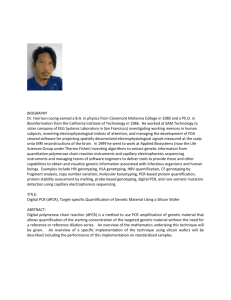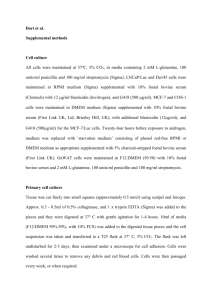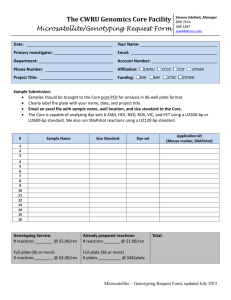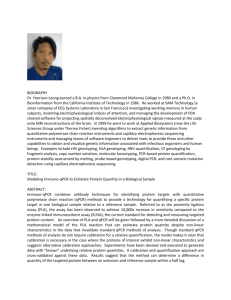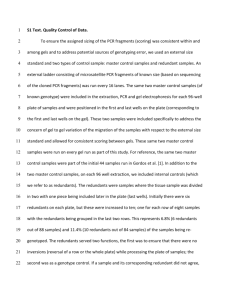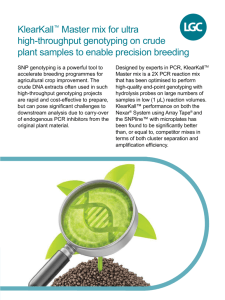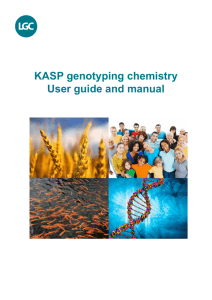SUPPLEMENTAL METHODS Methods used for genotyping As
advertisement
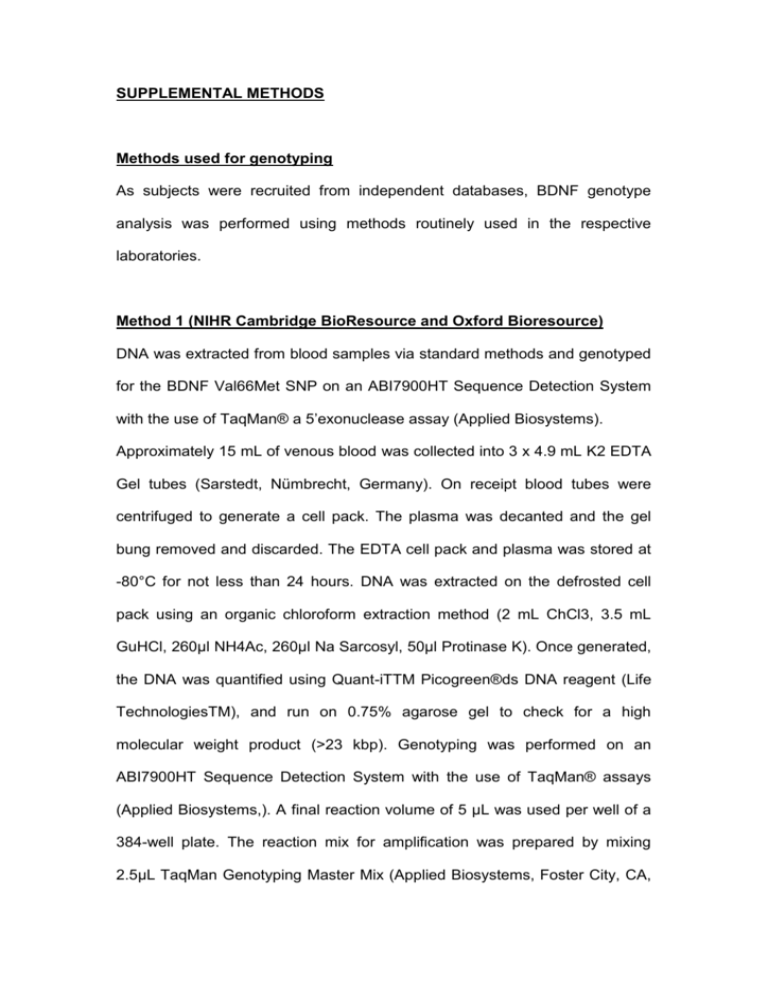
SUPPLEMENTAL METHODS Methods used for genotyping As subjects were recruited from independent databases, BDNF genotype analysis was performed using methods routinely used in the respective laboratories. Method 1 (NIHR Cambridge BioResource and Oxford Bioresource) DNA was extracted from blood samples via standard methods and genotyped for the BDNF Val66Met SNP on an ABI7900HT Sequence Detection System with the use of TaqMan® a 5’exonuclease assay (Applied Biosystems). Approximately 15 mL of venous blood was collected into 3 x 4.9 mL K2 EDTA Gel tubes (Sarstedt, Nümbrecht, Germany). On receipt blood tubes were centrifuged to generate a cell pack. The plasma was decanted and the gel bung removed and discarded. The EDTA cell pack and plasma was stored at -80°C for not less than 24 hours. DNA was extracted on the defrosted cell pack using an organic chloroform extraction method (2 mL ChCl3, 3.5 mL GuHCl, 260µl NH4Ac, 260µl Na Sarcosyl, 50µl Protinase K). Once generated, the DNA was quantified using Quant-iTTM Picogreen®ds DNA reagent (Life TechnologiesTM), and run on 0.75% agarose gel to check for a high molecular weight product (>23 kbp). Genotyping was performed on an ABI7900HT Sequence Detection System with the use of TaqMan® assays (Applied Biosystems,). A final reaction volume of 5 μL was used per well of a 384-well plate. The reaction mix for amplification was prepared by mixing 2.5μL TaqMan Genotyping Master Mix (Applied Biosystems, Foster City, CA, USA), 0.03μL of SNP Genotyping Assay (Applied Biosystems) and 0.47μL distilled water per sample. To this reaction mixture 2μL DNA solution (with a total of 8ng DNA) were added to achieve a final volume of 5μL. Amplification was performed using a protocol with 40 cycles, 15s at 92°C (denature), 1 min at 60°C (anneal/extend). An initial hold with 10 min at 95°C was applied. Analysis of data was performed according to the manufacturer's instructions. Primer sequences; forward: GGCTTGACATCATTGGCTGAC, reverse: GGTCCTCATCCAACAGCTCTT, Probe sequences; Vic: ACTTTCGAACACATGATAG, Fam: CTTTCGAACACGTGATAG. Method 2 (Glaxo Smithkline – Clinical Unit Cambridge) Genotyping was conducted by LGC Genomics (http://lgcgenomics.com/). SNPs were genotyped using the KASP SNP genotyping system. KASP is a competitive allele-specific PCR incorporating a FRET quencher cassette (see http://lgcgenomics.com/kasp-genotyping-reagents for more information). Venous blood was collected from each consented subject into an EDTA vacutainer. DNA was extracted using the Gentra Autopure LS automated DNA purification concentration and process by Quest quality of the Diagnostics isolated DNA Heston, were UK. verified The via spectrophotometry and agarose gel electrophoresis by the vendor and GSK laboratories, respectively. Genotyping was performed using a TaqMan® SNP Genotyping Assay (Applied Biosystems) at KBioSciences, Hoddesdon, Herts, UK. A total mixture, made from the universal master mix, the SNP-specific assay and molecular biology grade water was dispensed to the microtitre plates containing DNA using KBioscience’s Meridian liquid dispensing device. The plates were then sealed using KBioscience’s Fusion laser welding system which applies a permanent and hermetic seal of polypropylene, through which the eventual fluorescent signal can be determined. PCR was carried out in KBioscience’s waterbath-based thermal cycling system (Hydrocycler) using the following conditions: 15s at 94⁰ C (denature) and 1 min at 60 ⁰ C (anneal/extend) for a total of at least 35 cycles. An initial hold with 15min at 94⁰ C was applied. After PCR, the fluorescent signals from the TaqMan assay were read on a BMG Pherastar fluorescent plate reader. The raw fluorescent values for FAM, VIC and ROX were imported into KBioscience’s Kraken software and represented on a graphical cluster plot, showing FAM / ROX (xaxis) and VIC / ROX (y-axis). ROX is used in this genotyping system as a normalising dye. Reaction Volumes 1uL per well in 1536-well format, 3uL per well in 384-well format. A total mixture, made from the universal master mix, the SNP-specific assay (and molecular biology grade water to make the final concentrations correct), was dispensed to the 384-well or 1536-well microtitre plates using KBioscience’s Meridian liquid dispensing device. The plates (of either format) were then sealed using KBioscience’s Fusion laser welding system. The Fusion system applies a permanent and hermetic seal of polypropylene, through which the eventual fluorescent signal can be determined (see below). PCR cycles PCR was carried out in KBioscience’s waterbath-based thermal cycling system (Hydrocycler) using the following conditions: 94°C 15mins (enzyme activation) 94°C 15sec 60°C 60sec Steps (1) and (2) repeated to total of 35cycles. Post thermal cycling, the plate was read on a fluorescent plate reader (see below). Where the PCR had not reached completion or satisfactory genotyping groups had not yet been achieved, the samples were subjected to three further PCR cycles, of steps (2) – (3) again, and re-read on the plate reader. This process was repeated as required. Detection After PCR, the fluorescent signals from the assay were read on a BMG Pherastar fluorescent plate reader. The raw fluorescent values for FAM, VIC and ROX were imported into KBioscience’s Kraken software and represented on a graphical cluster plot, showing FAM / ROX (x-axis) and VIC / ROX (yaxis). ROX is used in this genotyping system as a normalising dye, negating any variances in FAM and VIC signal occurring due to well-to-well differences in liquid volume.
